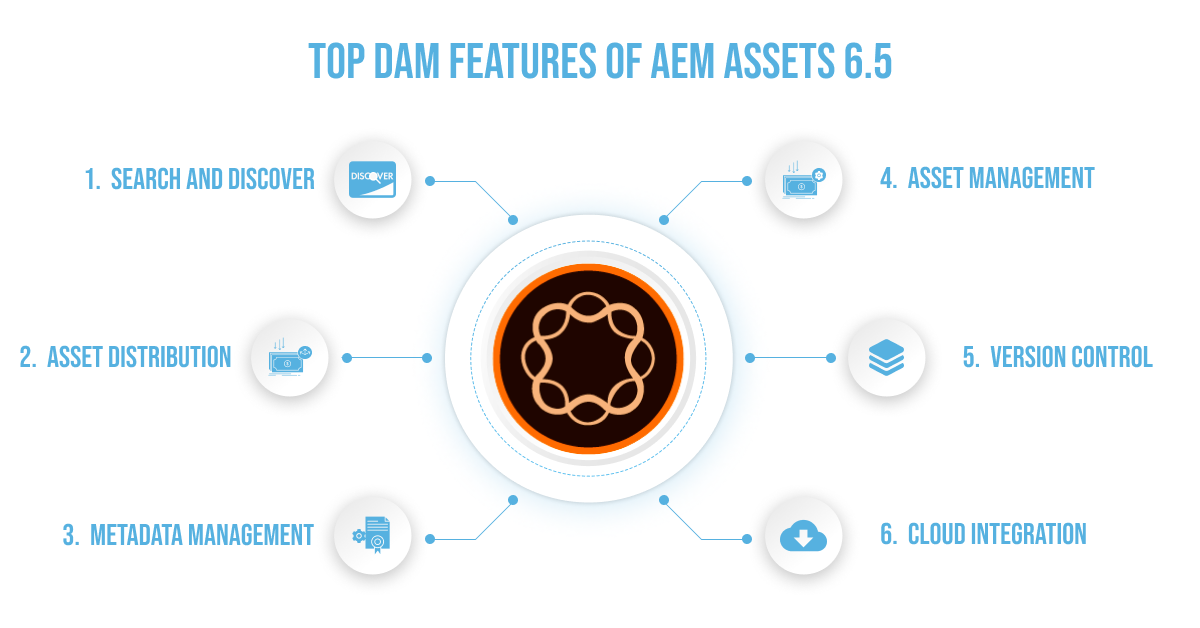User content personalization is the secret recipe to win your customer’s attention. If you’re struggling to convert your leads into valuable customers, chances are that your content lacks user personalization. It is comparatively easier for SMEs, startups and small businesses to connect directly with their users. On the flip side, enterprises find it a daunting task.
This is exactly when you need Adobe Experience Manager Assets, a unique Adobe offering that helps enterprises build customized and personalized digital content solutions. You don’t need to stress out about managing content across multiple devices and channels.
If you’re interested in learning more about Adobe Experience Manager Digital Asset Management (DAM), how it works, the benefits of the AEM Digital Asset Management tool and the measures to consider before implementing DAM for your enterprise, keep on reading!
What is Meant by Adobe Digital Asset Management?
Searching, collecting, analyzing and delivering content that resonates with each segment of your audience can be tricky. On top of that, creating specialized content for each channel and device is difficult. Adobe Experience Manager DAM takes the complete charge of managing, optimizing and delivering personalized experiences to your consumers, so that you can focus on the tasks that matter the most.
Adobe Experience Manager Assets is a Digital Asset Management (DAM) system that allows you to create, organize, store, manage, deliver, retrieve and optimize rich media such as images, videos, audio files, documents, forms, etc., to curate personalized user experiences.
Since AEM DAM is a scalable and flexible cloud-native offering, enterprises do not need to worry about sharing and delivering thousands of files in one go. No matter if you wish to share files across the globe to anyone, Adobe Experience Manager DAM is the answer to all the problems.
History of Adobe Experience Manager
Before October 2010, Adobe Experience Manager was not under Adobe’s proprietorship. It was called Day Communique or Day CQ, which was a Day software product. The software was created in Basel, Switzerland. It was only in October 2010 that the software was acquired by Adobe. It was then named Adobe Experience Manager (AEM).
Adobe has now released a new version called AEM 6.5.20.0. This latest version of AEM comes with enhanced capabilities, enhancements, features and bug fixes. It was later on that Adobe released its various products such as AEM as a Cloud Service (AEMaaCS) and AEM Digital Asset Management (DAM) is one of them.
How Does AEM Digital Asset Management Work?
Adobe Experience Manager (AEM) Assets is one of the significant offerings of Adobe’s suite, which is power-packed with cloud-based capabilities. It is a centralized Digital Asset Management (DAM) system that allows your team to manage, access, and optimize content from anywhere in the world.
You can share a variety of digital files such as images, videos, files, 3D models, etc. One of the best ways to understand how AEM works is through an example. Here it is!
By using Adobe Experience Manager Assets, you can share social media post templates directly with your team. This way, everyone in the company stays on the same page and can access the latest version of the content. Therefore, AEM Assets ensure content distribution across teams with utmost collaboration.
What are the Benefits of Using AEM Digital Asset Management?

The following are the highlighting benefits of using Adobe Experience Manager DAM:
1. Increased Team Efficiency by 10X
A digital asset management system is designed specifically to grow with the expansion of a business. By providing a single space for collaboration, creation, and feedback, it boosts productivity between creative, IT, marketing, and business teams. You can easily and widely satisfy the wants of your customers with such improved avenues for communication.
Because Adobe Experience Manager DAM offers strong metadata capabilities and a shared set of repositories for simultaneous file retrieval, using it also facilitates more rapid and efficient workflows.
2. Time-Saving with Automation
Adobe Experience Manager Assets is all about saving your precious time and focusing on what’s important. With enhanced AI capabilities, you can repurpose a single asset into a multitude of digital asset possibilities without hampering your time and digital resources.
You can deliver more personalized experiences with Adobe Assets AI, such as asset tagging, cropping and delivery across various touchpoints.
3. Flexibility to Work from Anywhere
You have the freedom to use your digital assets from any location with AEM Digital Asset Management. Your assets can be distributed, linked, and shared with anyone, anywhere in the world. You can review assets, collaborate with others, and get quick access with this functionality.
Workflows and metadata can also be used to create digital experiences that your end consumers won’t soon forget.
4. Supreme Media Delivery
Regardless of your need to distribute thousands of digital assets at once, AEM Digital Asset Management gives you the adaptability to swiftly and effectively produce, deliver, and modify an endless number of asset variations. With Adobe Experience Manager materials, you can create an engaging delivery experience that saves time and money when sending films or 3D materials.
Intriguing and captivating experiences such as 360-degree views, augmented reality, and virtual reality (VR) can also be produced.
5. Control Your Permissions
AEM Digital Asset Management boasts a robust authorization and rights management system. It can also be used to grant partners digital permissions so they can receive updates. You can also know precisely who is accessing them and all the information pertaining to the assets because of its increased openness.
Measures To Consider Before Implementing AEM Digital Asset Management
Here are the following steps you need to consider before implementing Adobe Experience Manager DAM software:
- Be Clear About Your Motive
Before adopting an AEM Digital Asset Management system, it is crucial to consider why you need it in the first place. If you’re struggling with efficient digital asset management and feel like your time and resources are getting wasted, it is one of the major signs to consider investing in AEM Assets.
Once you get a clear idea of why you need an AEM DAM system, it is important to consider other factors including, if you can reach your project goals with the adoption, if it can easily be integrated with the rest of your tech stack, and it ensures smooth implementation, etc.
- Establish a Dedicated Team
It is important to consider a knowledgeable team that can help implement a solid digital asset management solution. A wise choice ensures production, creation, and service-level team collaboration for the best outcome. A solid AEM Digital Asset Management team includes the following professionals:
- Project Manager
- DAM Initiative Leader
- DAM Librarians
- DAM Infrastructure Lead
- Project steering group
- Use Actual Data
Don’t make the mistake of using some ‘test’ data to check the efficiency of the system. Use real-life data, brand creative files and digital assets to formulate critical functionality and workflow requirements for your asset management system.
It is also important to perform various tasks diligently such as the efficient transfer of data from the current to a new system, seamless system performance while integrating with other products and aligning the file formats with the system.
- Focus on Improving Workflows
Rather than emphasizing upgrading your tech stack, it is pivotal to update workflows and structures according to the requirements. Ensure that you’re properly analyzing and then creating and storing marketing materials for various channels.
The created DAM solution must meet your company’s present requirements as well as future aspirations. You can optimize the process of DAM system implementation by streamlining your workflows, removing tasks that don’t add value, eliminating possible roadblocks and establishing a sustainable system.
- Customize Only When Necessary
It is not always necessary to add high-end customizations to your AEM Digital Asset Management (DAM) software. Implementing customizations can slow down performance, enhance software bugs and make the system more complex.
Therefore, it is a better choice to keep your system as generic as possible. It will be beneficial for your system in the long run.
- Divide Your Project
It is very important to divide your AEM DAM project into phases and then work on it step-by-step. By breaking your project into sequential blocks or phases, you can individually measure the outcome of particular steps and analyze the strategy accordingly.
It also becomes easy to address and identify unexpected outcomes and take robust actions. For enhanced productivity, you can dedicate specific teams to attain outputs for dedicated project phases.
Bottom Line
Adobe Experience Manager Digital Asset Management (DAM) is an all-exclusive and sophisticated Adobe product. Being a powerful tool, it has helped enterprises create unforgettable and more personalized experiences for users. Leveraging Adobe’s DAM helps you cater to brand consistency across all touchpoints. AEM DAM is indeed the heart of digital content creation.
Do you want to learn more about the capabilities of Digital Asset Management (DAM)? Fill out the form on our home website to transform your brand’s online image.
FAQs:
What is Adobe Experience Manager DAM?
Adobe Experience Manager DAM refers to the Digital Asset Management system. Adobe’s DAM is called Adobe Experience Manager Assets. It is an all-rounder solution for creating, storing, managing and delivering content across various digital channels and touchpoints. This cloud-native asset management solution promotes brand consistency and customer engagement through personalized content.
How does Digital Asset Management work?
Adobe’s Digital Asset Management (DAM) allows you to share a diverse range of media such as 3D videos, files, images, forms, documents, etc. and enables enhanced collaboration between product and service teams. This functionality helps them stay on the same page. From social media posts to marketing campaigns to analytics, Adobe Experience Manager DAM has got you covered with all of it.
What are the benefits of Digital Asset Management?
The benefits of Adobe DAM include enhanced team collaboration, time savings through automation, freedom to work from anywhere and share content with anyone, control of who can access the authorized files, and ease of media delivery.
What steps do I need to take before implementing Adobe Experience Manager DAM?
The first step is to analyze whether you need to enhance your tech stack when adopting the Adobe Experience Manager DAM. The next step is to create a dedicated team to address various phases of the AEM project. You can then also add any required customization to the DAM, however, it is recommended to keep the system as general as possible for robust functioning and a bug-free environment.


